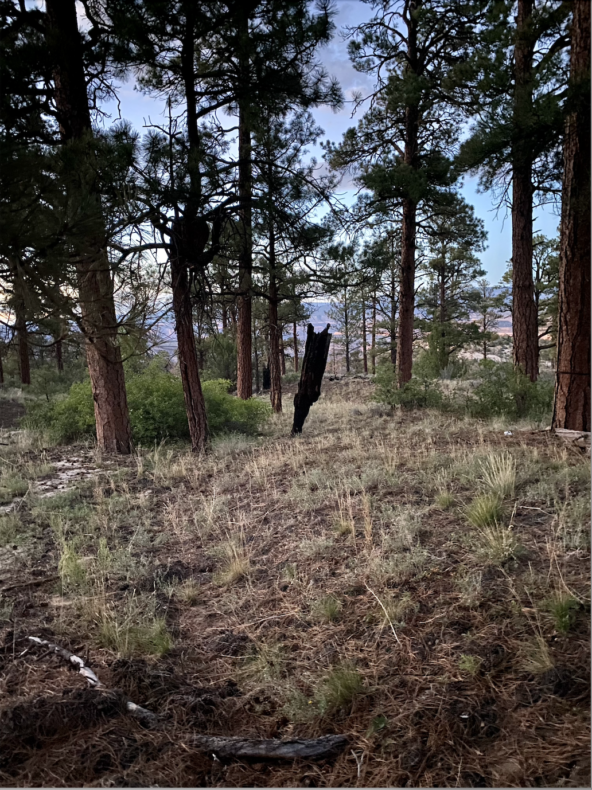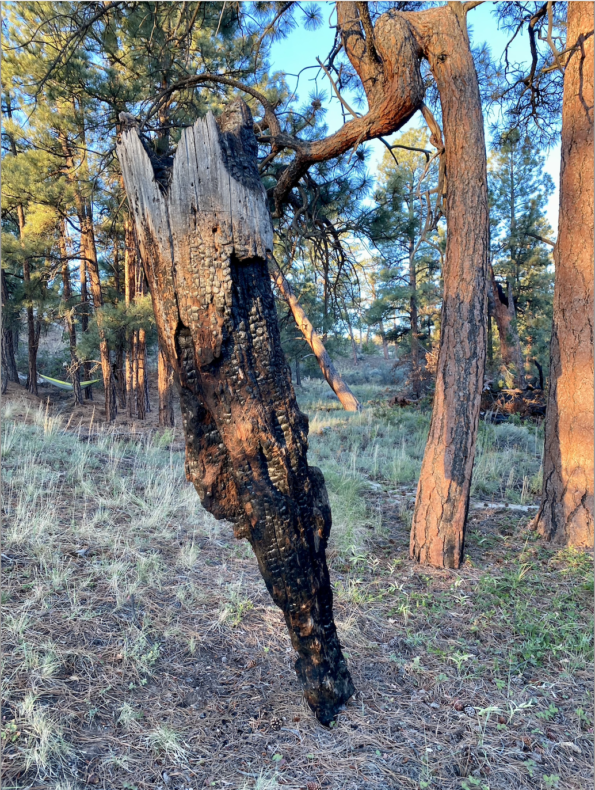
This concerns the burned out hulk of a ponderosa pine that bears have taken an interest in, sculpted, really. I recently saw this smoldered-black tree on a backpack with two friends in Western Colorado. The walk took four days with no human trails to speak of, so when we arrived, we were well away from human presence in a purely animal landscape.
One of the friends had found it weeks earlier, saying he considers this one of the most important finds of his life. It is a mysterious meeting place for bears. When I saw it from a hundred feet away, I thought the object was a big bear in the woods. A large tree will burn down in a wildfire and leave a hooded black stump that can be mistaken for a large animal. Through lines of standing, live ponderosas, catching it out of the side of my eye, it seemed to be standing on its hind legs, peering through the trees.
This had been a large ponderosa pine, at the peak of its life thirty or forty years ago. For whatever reason, it had grown at a slight angle, and a fire burned it down to about ten feet of trunk, the base smoldering into a stiletto. It looks like a half-ton charred ballerina standing on a single leg. At the top, on what appears to be a head, stands a pair of uncanny protuberances, not unlike the raised ears of a black bear, making it not a ballerina, but ursine, bulky in the chest, heads taller than any living bear.
You can tell something has been happening around this charred shell. A halo of pine needle duff has been pummeled flat by the weight of many bears over time. This has long been a focus of ursine attention. It stands like their shrine, like nothing the three of us had ever seen in the wild.
A closer look shows that bears have been mauling this object from top to bottom for decades. Its black surface holds so many swipes and rakes that parts of the tree have been scraped through inches of char down to bare, unburned wood. Big adults have embraced it on hind legs, forearms wrapped around the tree, gouging from both sides, while others came in at shoulder-level with long downward drags and crosshatches. Around the top are the markings of cubs, their claw marks closer together where they peeled at the carbonized head, climbing onto it like young kings and queens of the hill.
Other blackened trunks in the area have a swipe or two, but none like this. You’ll see trees that bears use as scratching posts and signboards. Aspens heal with black scars that can look like calligraphy, as if bears were writing to each other with their claws. This was not such a tree. If this were calligraphy, it would be an almost illegible palimpsest, each one writing over the last. They’d made it into an ursafact.
In about a fifty-foot radius, we found five or six recent bear beds where they’d come repeatedly to sleep or rest, leaving berried scat of various ages in the needle duff. It looked like some kind of Greek senate in my eyes, the council of bears gathered to debate some important issue. More likely, they came one at a time, sniffing, approaching with a wary posture. If they slept nearby it may have been to see if it moves.
Bears are known to be of high intelligence as we measure it, passing math tests that only primates, ravens, and octopi get. You look them in the eye, which you shouldn’t do, and you can see the questions in their demeanor, snouts pointed around like facial expressions. Building a bear-proof container or trash can has been a puzzle because human and bear intelligence does not always match up. A favorite quote from a Yosemite ranger reads, “There is considerable overlap between the intelligence of the smartest bears and the dumbest tourists.”
They knew this wasn’t a bear, but what was it to them? It held a place in their imagination. A behavior known as “strange object response” is known among animals where they leap away from something unknown, then creep forward to address and understand it. In some languages, that would be defined as curiosity. You’ve perhaps seen videos of bears encountering mirrors cleverly placed in the forest. In one, a black bear lunges, whips around and, confused, tears the mirror down from the tree.
Was this black trunk such an encounter, only it could not be torn down, would not budge? Is this why they attacked it, to get a reaction, to wake the unwakable bear?
We decided to camp here. I don’t know how wise this was, but late in the day, and wanting to study this tree further, we decided to pitch ourselves around it, somewhat like the bears had, forty, fifty feet apart, two taking to camp hammocks and me bedding in a small tent between them. If anything were to go awry in the night, a black bear is likely to back down from three banging, shouting adults. Besides, the treatments on the tree and the beds surrounding it looked like they’d had many months between visits. Bears were not frequent, only numerous over time, and we wouldn’t be catching them on the night they held court, the night that one wandered through to add to the many preceding it, another signature at the foot of the shrine.
We slept soundly. When we woke, the great bear stood like a slab of obsidian between us, its ears raised, listening.

Photos: cc
Beautiful imagery, as always. Thank you.
Weird and wonderful-
What a gift. Thank you
How mysterious! What could the bears possibly be doing? Some patient ursinologist will figure it out someday.
““strange object response” – Would that I had exercised that more in my life. On the other hand, I would have, and would still, miss out on more than a few harrowing and gorgeous adventures.
It’s so wonderful to be surprised and unable to explain. Our left brains have certainly grown, until we really think we can understand and explain everything. Thanks, Craig, for this reminder of how awesome and beyond us wildness is.